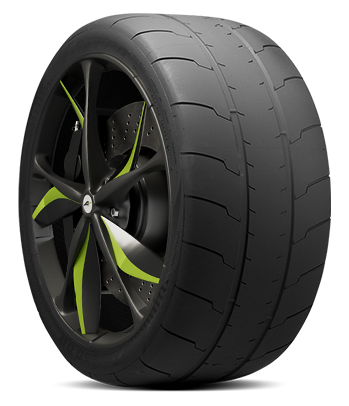Atturo AZ850DR DOT drag radial tires are engineered to provide maximum traction in straight-line performance while remaining street legal. To achieve consistent results and maximize tire life, proper care and handling are essential. This guide outlines best practices for break-in, air pressure management, temperature control, cleaning, and long-term storage.
Please note that these are good general guidelines for how to break in and maintain these tires. Every driver will develop their own preference and habits for tuning air pressure at the track and how much of a warmup their car needs.
1. Break-In and Heat Cycling
• Initial Scuff / Break-In: Before full-power use, perform a light scuff session to remove mold release agents from the tread. Avoid aggressive burnouts or wheelspin during this stage. This can be done with simple street driving, moderate acceleration and driving in alternating circles.
• Gradual Heat Cycling: On the first outing, progressively increase speed or load over several passes. Complete one hard run at the end to bring the tires up to full operating temperature.
• Cool-Down Period: After the initial cycle, allow the tires to cool naturally for at least 24 hours. This curing process stabilizes the rubber compound and extends competitive life.
• Ongoing Heat Management: Repeated heating and cooling will gradually harden the tread over time. Monitor grip levels and replace tires when traction noticeably diminishes.
2. Air Pressure Settings
• Street Use: Start at manufacturer-recommended pressures (typically mid-30s psi or higher). This provides stability, maintains even tread wear, and ensures proper load carrying.
• Drag Strip Use: Initial settings often start around 20 psi cold. Adjust downward in small increments until optimal traction is achieved without sidewall collapse.
- Too much pressure: Reduced traction, wear concentrated in the center.
- Too little pressure: Excessive sidewall flex, wear concentrated at edges.
• Hot vs. Cold Pressures: Always check pressure after a burnout or run, as heat will raise levels. Adjust based on hot readings, not cold alone, for consistency.
• Nitrogen Inflation (Optional): For more stable pressures, nitrogen can reduce pressure swings from heat compared to compressed air.
• It is critical to return to full street level air pressure after dropping it for a day at the strip. The tires will generate too much heat and degrade faster if pressure is kept that low for prolonged periods of street driving. Handling and wet traction are also reduced at low pressure.
3. Temperature Guidelines
• Operating Range: Tires deliver best performance when warmed through controlled burnouts or acceleration runs. Avoid aggressive use until they reach operating temperature.
• Cold Weather Risks: Do not store or operate tires below freezing (32 °F / 0 °C). Exposure to such conditions may cause cracking.
• Warming After Cold Storage: If tires have been exposed to near-freezing temperatures, allow them to warm for at least 24 hours indoors before mounting or flexing.
4. Cleaning & Maintenance
• Approved Cleaning: Use only mild soap and water with a soft cloth or sponge. Rinse thoroughly.
• Avoid the Tread Surface: Do not apply cleaners, dressings, or tire shine products to the tread. These chemicals can reduce traction.
• No Chemical Softeners: Do not use aftermarket “tire prep” or chemical treatments. These may compromise integrity, legality, and performance consistency.
• Tires are made with chemical compounds to help them reduce damage from ozone and other oxidants. New tires will often “bloom” as these chemicals are released when exposed to sunlight for the first time. This can create a brownish look to the tire and is completely normal. Simply wipe this off with soapy water.
• Beware of tire cleaners which leave behind a high gloss surface. These can often sling off and wind up on the tread area. They are also potentially damaging to the tread compound over time.
5. Long-Term Storage
• Unload Tires: If the vehicle will sit for extended periods, remove the tires or support the vehicle on jack stands to relieve weight.
• Deflation: Reduce pressure to around 5 psi for storage.
• Environment: Store in a cool, dry, dark place, away from direct sunlight, heat sources, or ozone-producing equipment (motors, welders, compressors). An unheated garage in below freezing temperatures is a bad winter storage spot! Take your tires inside to the basement if possible.
• Packaging: For off-season storage, place each tire in an opaque plastic bag to reduce exposure to light and air. A large black yard waste bag is perfect. There are purpose built tire storage bags which are also good options.
• Stacking: Lay tires flat and stack them. Avoid upright storage for long durations, which can create flat spots.
6. Key Safety Reminders
• Inspect before each use for cracks, cuts, or irregular wear.
• Never exceed speed or load ratings.
• Replace tires that have hardened significantly or no longer provide adequate traction.
• Remember that DOT drag radials are optimized for straight-line performance and will have reduced cornering and wet-weather grip compared to standard street tires.
• Avoid rough surfaces like gravel. The abrasive surface will quickly degrade the tread life.
Following these guidelines will help ensure maximum traction, consistency, and safety while extending the service life of your Atturo AZ850DR DOT drag radial tires.





